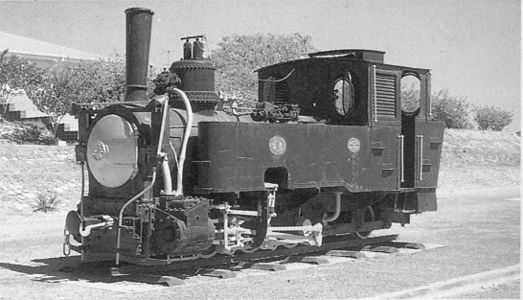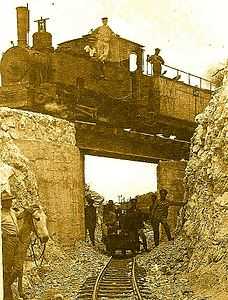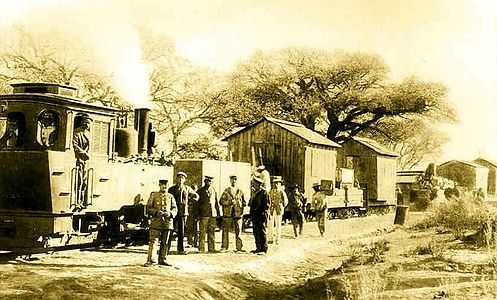South West African Jung
| South West African Jung 0-6-2T ex DSWA Jung 0-6-2T | |
|---|---|
|
Jung 0-6-2T no. 9 plinthed in Tsumeb, Namibia, 17 February 2011 | |
| Type and origin | |
| Power type | Steam |
| Designer | Arnold Jung Lokomotivfabrik |
| Builder | Arnold Jung Lokomotivfabrik |
| Build date | 1904 |
| Specifications | |
| Configuration | 0-6-2T |
| Gauge | 600 mm (1 ft 11 5⁄8 in) narrow gauge |
| Driver diameter | 27 9⁄16 in (700 mm) |
| Wheelbase |
5 ft 6 7⁄8 in (1.699 m) coupled wheels 11 ft 7 3⁄4 in (3.550 m) engine 16 ft 5 in (5.004 m) tender |
| Length |
22 ft 9 5⁄8 in (6.950 m) as tank engine 39 ft 6 3⁄4 in (12.059 m) with tender |
| Width | 6 ft 10 in (2.083 m) |
| Height | 10 ft 4 in (3.150 m) |
| Locomotive weight | 21 12⁄20 long tons (21.9 t) w/o |
| Tender type | 2-axle bogies |
| Fuel type | Coal |
| Fuel capacity |
3⁄4 long ton (0.76 t) engine 1 long ton (1.0 t) tender |
| Water capacity |
770 imp gal (3,500 l; 920 US gal) engine 1,188 imp gal (5,400 l; 1,427 US gal) tender |
| Boiler pressure | 171 psi (1,180 kPa) |
| Firegrate area | 7.7 sq ft (0.715 m2) |
| Heating surface: – Firebox | 38.5 sq ft (3.58 m2) |
| Cylinders | Two |
| Cylinder size |
11 13⁄16 in (300 mm) bore 13 25⁄32 in (350 mm) stroke |
| Valve gear | Walschaerts |
| Performance figures | |
| Tractive effort | 8,928 lbf (40 kN) at 75% pressure |
| Career | |
| Operator(s) |
Otavi Mining and Railway Company South African Railways |
| Number in class | 15 |
| Number(s) | 1-15 |
| Delivered | 1904 |
| First run | 1904 [1][2] |
The South West African Jung 0-6-2T of 1904 is a South West African steam locomotive from the Deutsch-Südwest-Afrika era.
In 1904 the Otavi Mining and Railway Company in Deutsch-Südwest-Afrika, now Namibia, acquired fifteen 0-6-2 tank locomotives from Arnold Jung in Germany. Two of them survived to be taken onto the South African Railways roster in 1922.[1][2]
The Otavi Railway
Construction of the 600 millimetres (23.6 inches) narrow gauge Otavi railway line in Deutsch-Südwest-Afrika (DSWA), heading northeastward from Swakopmund via Usakos and Otjiwarongo, commenced in 1903 and was completed through Otavi and on to Tsumeb in August 1906. From Swakopmund to Usakos the line ran more or less parallel and to the north of the original Swakopmund-Windhuk Staatsbahn that had been constructed from 1897.[2]
In 1905 a short 14 kilometres (9 miles) branchline was constructed from Onguati near Usakos on the Otavi line to Karibib on the Staatsbahn to create an alternative line from Windhoek to the Atlantic Ocean at times when the Staatsbahn's section through the Khan River gorge suffered from the occasional flooding.[2]
On 1 April 1910 the Otavi line and its assets were purchased by the German Administration under an agreement in terms of which the mining company would continue to operate the line for a further ten years, while the problematic Khan River section of the Staatsbahn line could eventually be closed.[2]
Manufacturer
The first locomotives for the Otavi Railway were fifteen 0-6-2 tank steam locomotives that were built by Arnold Jung Lokomotivfabrik in Germany in 1904. They used Walschaerts valve gear and were numbered in the range from 1 to 15. Since the line traversed the Namib Desert, they were often used with a rectangular auxiliary water tank in tow.[1][2]
South African Railways
During World War I the former German Colony came under South African administration and the railways in DSWA came under control of the Union Defence Forces. Control of all railway operations in South West Africa (SWA) was passed on from the Military to the Director of Railways in Windhoek on 1 August 1915. On 1 April 1922 all the railway lines and rolling stock in the territory became part of the South African Railways (SAR).[1]
Two of these locomotives survived into the SAR era, no. 1 and no. 13, the rest by then having either been scrapped or, like no. 9 that is preserved at Tsumeb, sold to industry. Both SAR locomotives were subsequently modified to tank-and-tender locomotives by removing their coal bunkers and adapting the rectangular auxiliary water tenders to coal-and-water tenders.[1][2]
Service illustrated
The pictures of no. 9 serve to illustrate both sides of the Jung locomotive.
-

Jung 0-6-2T no. 9 at Tsumeb, left side
-

Jung locomotive, c. 1905
-

Jung locomotive, c. 1906
-
Jung 0-6-2T no. 1 on a work train near Tsumeb, c. 1931
See also
- List of South African locomotive classes
- South African locomotive history
- The 0-6-2 wheel arrangement
References
|
- ↑ 1.0 1.1 1.2 1.3 1.4 Paxton, Leith; Bourne, David (1985). Locomotives of the South African Railways (1st ed.). Cape Town: Struik. p. 115. ISBN 0869772112.
- ↑ 2.0 2.1 2.2 2.3 2.4 2.5 2.6 Dulez, Jean A. (2012). Railways of Southern Africa 150 Years (Commemorating One Hundred and Fifty Years of Railways on the Sub-Continent - Complete Motive Power Classifications and Famous Trains - 1860-2011) (1st ed.). Garden View, Johannesburg, South Africa: Vidrail Productions. pp. 235, 379–382. ISBN 9 780620 512282.